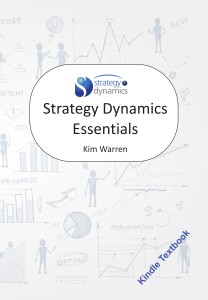Kim Warren on Strategy
Strategy insights and living business models
More on growth vs. ROIC
One challenge I got from the academics on the issue of strategy tools’ usefulness was whether growth is still a relevant question in these recessionary times.
Perhaps my original post to them was not clear enough. I meant to say that, as I understand it, investors are interested in the present value of future cash-flows – not growth per se. There is no point in simply growing market share or revenues if it does not ultimately improve future cash flows [the error that followed misuse of the growth-share notions from BCG in the 70s]. But as we speak, companies are understandably trying hard to maintain revenues In the current recession [i.e. minimise negative growth] as well as hold up profitability.
If this is right, the recession makes no difference to the fundamental point. If cash flows with poor or average strategy would likely decline sharply, and good strategic management would lead to a better cash-flow trajectory, then that is what will be best for investors and what management should be pursuing. Profitability [ROIC or similar] is but one lever to achieve that – and one that comes with big dangers. If your ROIC was previously 10% and recession hits it down to -5%, then investors would no doubt like to see it back up to, say, 5% … unless 5% and no subsequent growth was all they would ever see thereafter.
Percentages are not at all helpful in all this. If this scenario meant that your 10% ROIC corresponded to profits [or more strictly free cash-flows] of $10m/year, investors should prefer you to accept the minus-$5m if it meant that next year you get back to say, zero, then $10m, then $15m etc rather than $5m/year for ever.
Maybe the main reason firms pursue dangerous cost-cutting in a desperate attempt to prop up profitability is precisely because the naïve analysts who comment on their performance understand so little about the link from good strategic management to a firm’s value, and constantly bully management for ‘poor profitability’, rather than asking whether current profitability is actually in investors’ best interests. For an example, see my blog-post on what looks like a big strategic error by Starbucks, who are trying to sustain profitability by cutting costs sharply – including the costs of supporting exactly the ‘sustained competitive advantage’ that drove their historic strong growth in cash flows .. their unique investment in staff rewards and training which features in so many great case studies on the company.
To see a powerful and lucid explanation of why growth in free cash-flow is the right measure for investors and executives [and strategy researchers!] to focus on, see the statement from Jeff Bezos, founder and CEO of Amazon.com that opens the company’s 2004 Annual Report . Prior to founding Amazon.com, Jeff was a star Wall St analyst .. to be distinguished from the more average folk in that world.
Professional guidance on the same issue features in many finance reference books, e.g. Copeland, Koller, and Murrin, Valuation—Measuring and Managing the Value of Companies, Wiley, Chichester .. . It’s not perfect – e.g. the section on forecasting growth is way off, but as regards how firm performance is valued, it looks like essential reading for anyone planning to teach strategy.
Copyright © 2025 Kim Warren on Strategy. All rights reserved

